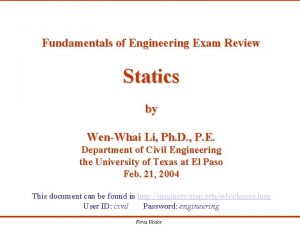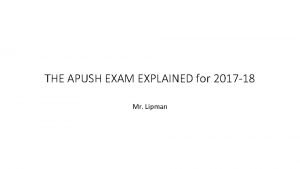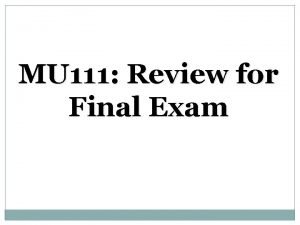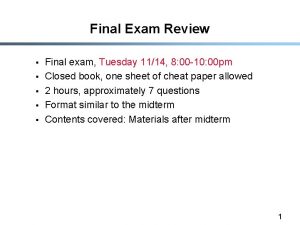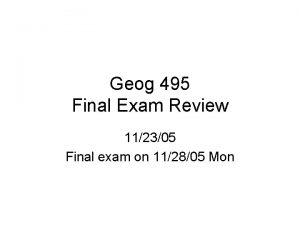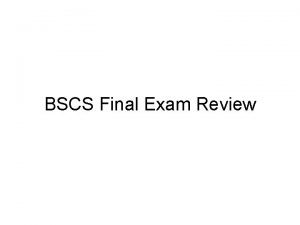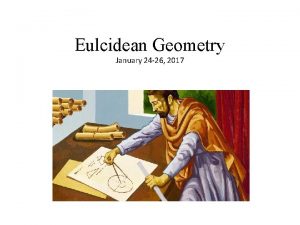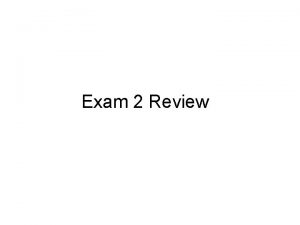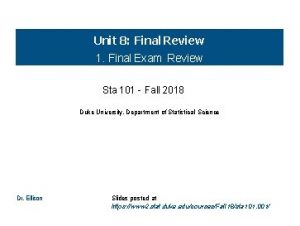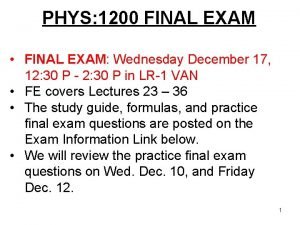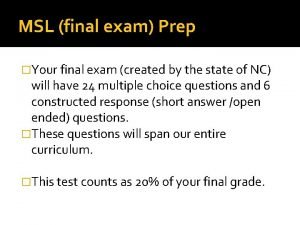2017 Geometry Final Exam Review Topics First Hour




































- Slides: 36

2017 Geometry Final Exam Review Topics First Hour

Area Formulas

Area of a Regular Polygon 1. Calculate the perimeter of the polygon 2. Determine the apothem of the polygon 3. Plug in the perimeter and apothem into the formula, P stands for perimeter and A stands for the apothem 4. Solve the problem

Area Formula A=½*a*b*sin. C This is a way to find the area of a triangle without having a base or a height, you only need two sides and the angle IN BETWEEN in the triangle. A=½*13*4*sin(70) A=½*52*sin(70) A=½*40. 2 A=20. 1 cm^2

Trigonometry

RULES FOR 30 -60 -90 TRIANGLES • The shortest leg is across from the 30 -degree angle. • The length of the hypotenuse is always two times the length of the shortest leg. • You can find the long leg by multiplying the short leg by the square root of 3. • The side opposite the 30° angle is always the smallest Lydia Abraham, 1 st hr.

SINE AND COSINE OF COMPLIMENTARY ANGLES Izzy Klida v COMPLIMENTARY ANGLES ARE ANGLES THAT TOGETHER SUM UP TO BE 90 DEGREES v THE SINE OF AN ANGLE EQUALS THE COSINE OF ITS COMPLIMENT v EXAMPLES v The sine of angle A is. 3746, and the cosine of angle B is also. 3746 v The sine of angle Q is. 8660, and the cosine of angle P is also. 8660

Using sine to find the missing side. You use sine when you have to find the length of the opposite or the hypotenuse side. You set up the equation like this. Sin(x)= opposite/hypotenuse In the equation x stands for the angle measurement that is given You plug in the number and information you already know This is how the picture below is solved. Sin(53)= x/15 You then have to cross multiply to finish the equation 15 X Sin(53)=x X=11. 98

USE SINE TO FIND A MISSING ANGLE -1 sin = Type this into your calculator exactly Our missing angle is about 48. 6

Using Cosine to Find the Missing Side By Maya Guiao The Law of Cosines can be used to find the missing side of any triangle when given two sides and an angle in between. Formula- Cos(Angle)= Adjacent/Hypotenuse Example:

Using cosines to find a missing angle First you take the adjacent and hypotenuse sides and divide them Once you do that you inverse cosine the answer now you have your missing angle Nick Hill

USE TANGENT TO FIND A MISSING SIDE: Ex: Opposite is x Adjacent is 14 Tangent angle is 67 Tangent x= opposite/ adjacent Step 1: Tangent 67= x/14 Step 2: Cross Multiply 14 x tangent 67= x Step 3: Plug into calculator 14 x tangent 67 Answer: x= 32. 98

Using Tangent To Find Missing Angle Jamie Butts Tangent: a trigonometric function that is equal to the ratio of the sides opposite and adjacent to an angle in a right triangle. Step 1. Label the triangle’s sides as opposite, adjacent, and the hypotenuse Step 2. Looking at SOHCAHTOA, we have to calculate the opposite over the adjacent Step 3. Find the angle from your calculator using tan-1

Law of Sines (missing side) Define: The Law of Sines is the relationship between a side and an angle in triangles, either oblique or right. Example: sin 77°/15=sin 23°/c sin 77° (c)=sin 23° (15) c=(sin 23°*15)/sin 77° c=(5. 86)/sin 77° c=6. 015 units

Caitlyn Oudbier Law of Sines, missing angle measure § Formula- Sin. A = Sin. B a b § Must have a pair of angle side “buddies”, <A & a, <B & b, <C & c (capital letter-angle, lowercase letter- side length) In <PQR, m<R=97. 5*, r=80, p=75. Find m<P Q § Match the angle and side length opposite/across from each other(plug into formula(Sin. A/a), do the same for <B & b but the other angle will be missing. -------------------------------------------------- 80 ? P 75 97. 5* R Step 1: Sin 97. 5 = Sin<P Step 2: (80)(sin<P) = (sin 97. 5)(75) 80 75 80 Step 3: Sin<P =. 929479558 -1 sin ( ) <P = 68. 4*

Law of Cosines(Missing Sides) Steps 1. Identify angle C. It is the angle whose measure you know. Formula 2. Identify a and b as the sides that are not across from angle C. 3. Substitute the values into the Law of Cosines. 4. Solve the equation for the missing side. Identify C Angle and a/b sides Substitute into Formula Solve Equation C Equals Bobby Gray

LAW OF COSINE (MISSING ANGLE) •

Circles

Definition of a Circle DEFINITION OF A CIRCLE - ALL POINTS ON A PLANE THAT ARE X DISTANCE AWAY FROM A POINT (THE DISTANCE BEING THE RADIUS) It’s important to know the actual definition of a circle rather than being just l Like “Hey! I recognize that shape! That’s a circle!” Knowing the actual definition of the shape is important to Geometry and there’s a chance it’ll be on the test. Jackson V

Alija Jakupovic 1 st. Hr. How to derive the formula for the area of a circle. TO DERIVE THE FORMULA FOR CALCULATING THE AREA OF A CIRCLE, CUT A CIRCLE INTO EQUAL PIECES AND ARRANGE THEM INTO A ROW SO THE ALTERNATING TIPS FACE UP AND DOWN TO FORM A SHAPE LIKE A PARALLELOGRAM. EX.

ARC LENGTH Formula- Example- 10 is the radius and 57 is the interior angle

Alex Brown-Rohe Sector Area (Decimal Form)

SECTOR AREA Degree of sector-x Sector: part of a circles area Equation to find the area of a sector: x/360*pi(r)^2 Degree of sector(x) divided by 360 multiplied by area, pi(r)^2. Putting something in pi form means to keep the pi symbol on your final answer. to keep it in pi form don’t multiply it by pi in the equation radius Giuliana Capitanio

Inscribed Angles “An inscribed angle is an angle formed by two chords in a circle which have a common endpoint. This common endpoint forms the vertex of the inscribed angle. The other two endpoints define what we call an Intercepted arc on the circle. ” Ex: Angle measure ABC in the example will be HALF the measure of arc AC, and vice versa. An inscribed angle does not go through the center, it just shares a point with the side of the circle. Q: If angle ABC equals 55 deg, then what does arc AC equal? A: 110 deg, because the arc measure is twice the amount of the angle measure. Maddie Brown

Distance from Chord given Radius and Chord

TANGENT LINES A tangent line is a line that touches a curve at a point without crossing over. A tangent line to a circle is when a line touches the circle at one point but never touches the circle’s interior.

5 Tangent lines to a circle 3 This topic is also known as “clown hats” 4 With this topic, we need to find the length of the tangents along the circle to find the perimeter of the shape. When two tangents connect at an edge it creates an almost equilateral triangle, and both sides of the triangle are the same length, so if we know one side length, we can swing it over to the other side, and now we have both. In the example above, we can find the total perimeter using this method. In the bottom left, we know one side length is 4, so the other side that its connected to is also 4. We can do the same thing with the 5 and 3, simply swing the length over to the other side. Know that we know the length of all of the sides, we can add them all together to get the total perimeter : 4 +5 + 3 +3 = 24 units Rachel Coluzzi

Construct a Tangent Line (Zach Schmatz) Constructing a tangent line can be very simple if you know steps. (Pictures provided by Math Open Reference. ) 1. Draw a line from the center of the circle through the point. 4. Use your compass to draw two arcs from those first two arcs. 2. Use a compass to draw two arcs from the point on the circle. 5. Draw a line from the new point through the point on the circle. 3. Set your compass to a length longer than the line OP. Done!

3 D Geometry

Identifying Geometric Solids This image contains square pyramids, rectangular prisms, a sphere , and more solids. In this image, there are rectangular prisms, cylinders, and many more complex solids. To identify geometric solids, look at the number and shape of bases. These help you determine the type of solid. Reilly Asher

Cross Sections Irlanda Beltran The cross section is the 2 D shape shown when a flat cut is made in a 3 D figure.

Solids Of Revolution Brianne Bayer • A solid figure rotating around a plane to make a 3 D object • A triangle around a plane makes a cone • A rectangle around a plane makes a cylinder • A circle around a plane makes a sphere •

HOW TO FIND VOLUME OF A CYLINDER

How do you find the volume of a sphere? ▪ R D Joshua Gamble 10

FIND THE VOLUME OF A SQUARE PYRAMID! -Volume is the amount of space an object occupies 5 in. Equation: bh 3 - Start by finding the surface area of the base -The example shows a square pyramid with… A base of 36 in squared (6 x 6) A height of 5 in. 6 in. -The equation is… 36 x 5 = 180 = 60 in cubed 3 3 6 in.

RELATIONSHIPS OF CYLINDERS/CONES & PRISMS/ PYRAMIDS
 Uncontrollable spending ap gov
Uncontrollable spending ap gov Geometry final review
Geometry final review World history spring final exam review answers
World history spring final exam review answers Spanish 1 review packet
Spanish 1 review packet Human body systems final exam
Human body systems final exam Poe final review
Poe final review Ied final exam
Ied final exam Us history semester exam review answers
Us history semester exam review answers Principles of business final exam answer key
Principles of business final exam answer key Spanish 2 review packet
Spanish 2 review packet Environmental science final exam study guide
Environmental science final exam study guide Ap world history jeopardy review game
Ap world history jeopardy review game American history semester 2 final exam
American history semester 2 final exam English 11 a semester exam
English 11 a semester exam Physics fall final exam review
Physics fall final exam review Physical science final exam review
Physical science final exam review Mat1033 final exam
Mat1033 final exam Statics final exam review
Statics final exam review Zoology final exam review
Zoology final exam review Earth science sol review
Earth science sol review Final exam review algebra 1
Final exam review algebra 1 Accounting 1 final exam
Accounting 1 final exam Personal finance final exam review
Personal finance final exam review Spanish 2 final exam review
Spanish 2 final exam review Psyc 1504 final exam
Psyc 1504 final exam Geometry midterm exam review
Geometry midterm exam review Chemistry first semester exam review
Chemistry first semester exam review 24 hour format clock
24 hour format clock Semester vs trimester
Semester vs trimester Chapter 9 topics in analytic geometry
Chapter 9 topics in analytic geometry She carried herself unwittingly like a goddess of victory
She carried herself unwittingly like a goddess of victory Vcaa 2017 english exam
Vcaa 2017 english exam 2017 apush exam
2017 apush exam Flacs checkpoint b spanish exam june 2018 answers
Flacs checkpoint b spanish exam june 2018 answers 2017 ap chemistry practice exam
2017 ap chemistry practice exam Design process vcaa
Design process vcaa Cdes psychology conference
Cdes psychology conference

















